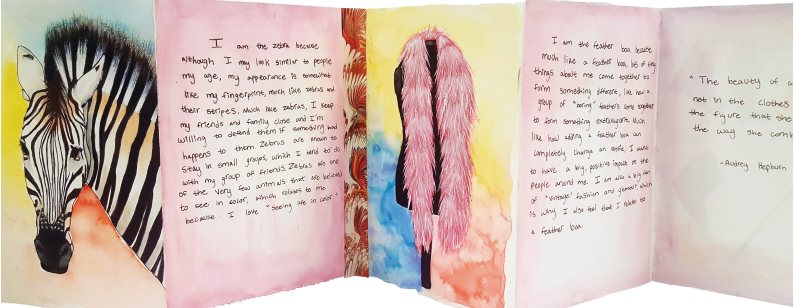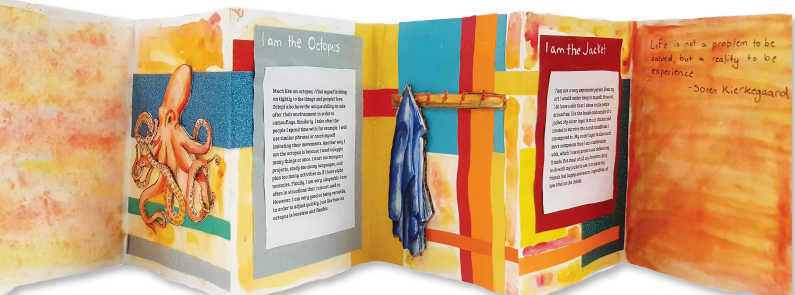
Producing a summative statement reflecting upon the creative process encourages the making of work that not only meets the aesthetic criteria, but also carries a deeper meaning.
In the experience that I call “the Pineapple and the Suitcase,” the student-artist is invited to create an accordion book in which metaphors, similes, and other forms of comparison are used to illustrate selected personal characteristics of the artist. Since I am no longer in the classroom, art teacher Betsy DiJulio kindly agreed to test the lesson with her students.
The product of this process is a book that contains a cover page, one visual image for each object, a page of text for each of the two objects, and a concluding quote. Betsy asked students to include a self-portrait on their cover.

Accordion books by Christina Liu (left) and Daphne Perotta (right).
The Pineapple and the Suitcase I invite you to do this project alongside your students. This shows your interest and commitment in the process as well as your involvement as a creative artist.
Oddly, the title for my example, The Pineapple and The Suitcase, came first and I just ran with it. To me, the patterns in a pineapple are orderly and its spiky green leaves represent that I am driven and direct. This translates into my passion and commitment for art and teaching, and reflects my continued personal growth.
The suitcase represents a willingness to travel and is a survival kit, as you have everything you
need with you. The wheels on the suitcase show fluidity of movement as they change directions easily. This supports the idea that our lives have fluidity and we have the ability to adapt.
Introduction
Begin by sharing and defining with students these words:
-
Comparison: looks at the similarities existing between two things.
-
Contrast: looks at the differences existing between two things.
-
Metaphor: A figure of speech containing a comparison in which a word or phrase ordinarily used of one thing is applied to another. Example: “Mark is a night owl.”
-
Simile: A figure of speech in which two unlike things are explicitly compared. Example: “He is hungry as a horse.”
-
Accordion: To fold into pleats resembling the billows of an accordion.
The Visual Problem
The student will:
-
Develop an accordion book by choosing an organic object (something from nature) and an inorganic object (something human-made) that are polar opposites. These carefully selected objects will share metaphorical connections.
-
Generate a list of four or five unique characteristics for each of the selected objects.
-
Develop a visual representation for each object and share his or her written insights.
Step One
Have students begin to think about and reflect on metaphors, similes, and comparisons found in their personalities as they relate to opposites. Ask them to pick an object from nature and an object that is manufactured. Students are to consider two very diverse objects as this approach allows for a more personal and engaging story and provides many subjective interpretation possibilities. Encourage students to have four or five similarities to both the organic and inorganic objects they have chosen.
Step Two: Accordion Book Process
- Begin by brainstorming possibilities, and then think through ideas that offer the most potential.
- Make a list of the qualities that each object has.
- Create a visual image of the two objects you have selected in an accordion book that includes a title page, two pages for images of the selected objects, followed by two pages of text. One last page should include a closing thought and the name of the student. This could also be a page that visually blends the two opposite words the student has chosen into a cohesive artistic image. You can opt to have the last page a philosophy statement or an image that blends the two opposite subjects you have chosen. Use any media of your choice.
Evaluation
When the books are complete, ask students to consider: Do these two opposites you chose show a wide range of personality traits? What are three or four ways that you are like the objects you selected? How revealing was this process, and did you have any surprises as you developed your ideas?

Accordion book by Nadia Msalek.
Interpretation by Betsy DiJulio
I was delighted when SchoolArts editor, Nancy Walkup, invited me to “test” Ken Vieth’s accordion book lesson. I chose to work with two fairly large sections of second-year art students, including those in our school’s International Baccalaureate Diploma Program, those who receive special education services, and virtually every level in between.
Successes and Challenges
As you can imagine, results were somewhat mixed due to varying levels of skill, intrinsic motivation, academic ability, effective work habits, and habits of mind. There were, however, many successes. Most students were able to demonstrate incremental learning in some small area, even if their books were low in quality overall.
Partly because I work on metaphors with my students beginning in my Art Foundations class, they grasped the concept fairly easily of choosing both organic and human-made objects to serve as metaphors for their personal identities—as opposed to objects that merely represented their interests—and were able to explain their selections in writing. Success levels related to the drawing and painting of the objects were commensurate with each student’s skill level, effort, and engagement.
A surprising number of students had difficulty designing the book. After I demonstrated how to create the basic accordion-folded framework from strips of tag board, some students ran with it, creating designs of beauty and innovation using scraps of colored and textured papers that had been donated to us. Others were overwhelmed, so I broke it down a little further, showing them how to create a color harmony that lent unity and interest by simply lining each page with the donated papers, cut to size.
Solutions
In the future, I would likely demonstrate the making of the book, including lined pages, in a more step-by-step, albeit restrictive, convergent, and teacher-driven, process. Students could then add their objects and writing to this basic framework. Or, if inspired to do so, they could embellish the pages to create an overall design of greater complexity, refinement, and artistry.
I might also include a block in our media center in which all students would write and print out their statements and concluding quotes. Then, whoever wanted to handwrite the
text into their books would have that option. And, at the risk of tightening down the process even further, I might specify blocks during which all students would work on their drawings or paintings of the organic object and the human-made object, instead of allowing them to work on parts of the book in whatever order they chose.
Finally, so that all students achieve at the highest level of which they are capable, I am considering asking students who were disappointed in their books to cut out the best aspects and reassemble them into a more successful work of art.
Conclusion by Ken Vieth
When we affix symbolic meaning to random objects, we may discover complexities in our own lives that we did not know were there. By looking at opposites, we begin to see how divergent we are as people. This realization can foster a greater appreciation and acceptance of all people and their differences as an asset rather than a liability. Students can benefit in unexpected ways when they analyze, synthesize, and cross-reference information involved in successfully solving this visual problem.
Note: This lesson provides a great opportunity to collaborate with an English language arts colleague!
Betsy DiJulio is a National Board Certified art teacher at Princess Anne High School, Virginia Beach, Virginia, and a regular contributor to SchoolArts. Elizabeth.DiJulio@VBSchools
Ken Vieth is an art educator and artist, the author of From Ordinary to Extraordinary and Engaging the Adolescent Mind, and a co-author of The Visual Experience, all published by Davis. KCVieth@Gmail.com
NATIONAL STANDARD
Creating: Conceiving and developing new artistic ideas and work.
WEB LINK
High school art curriculum and resources
View this article in the digital edition.





